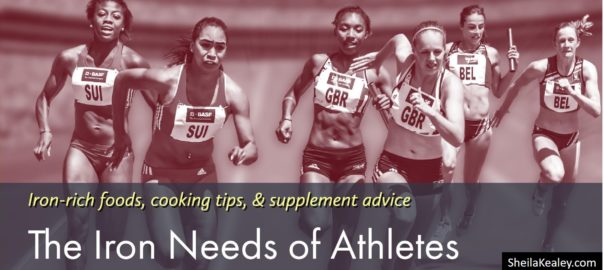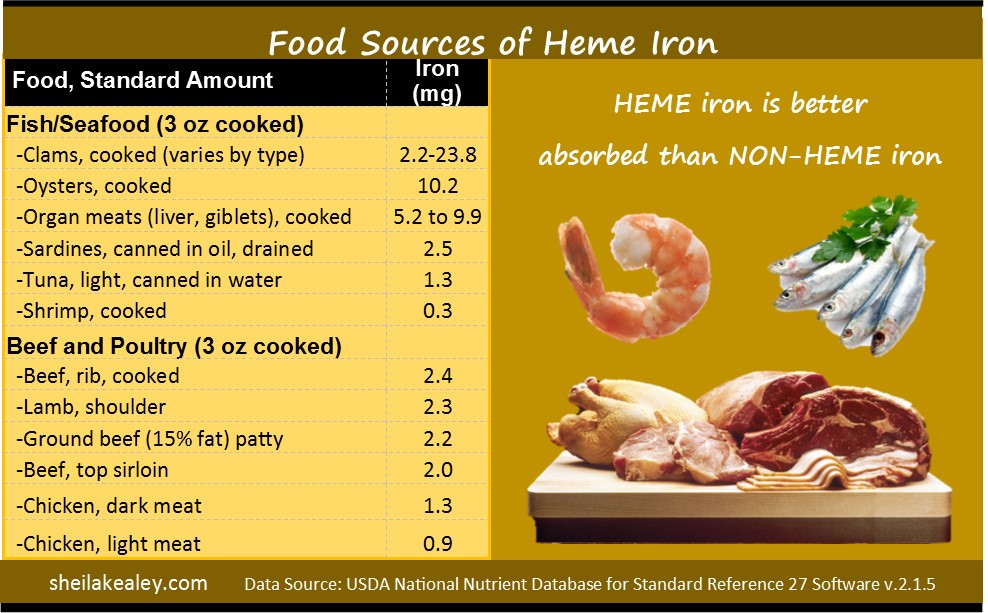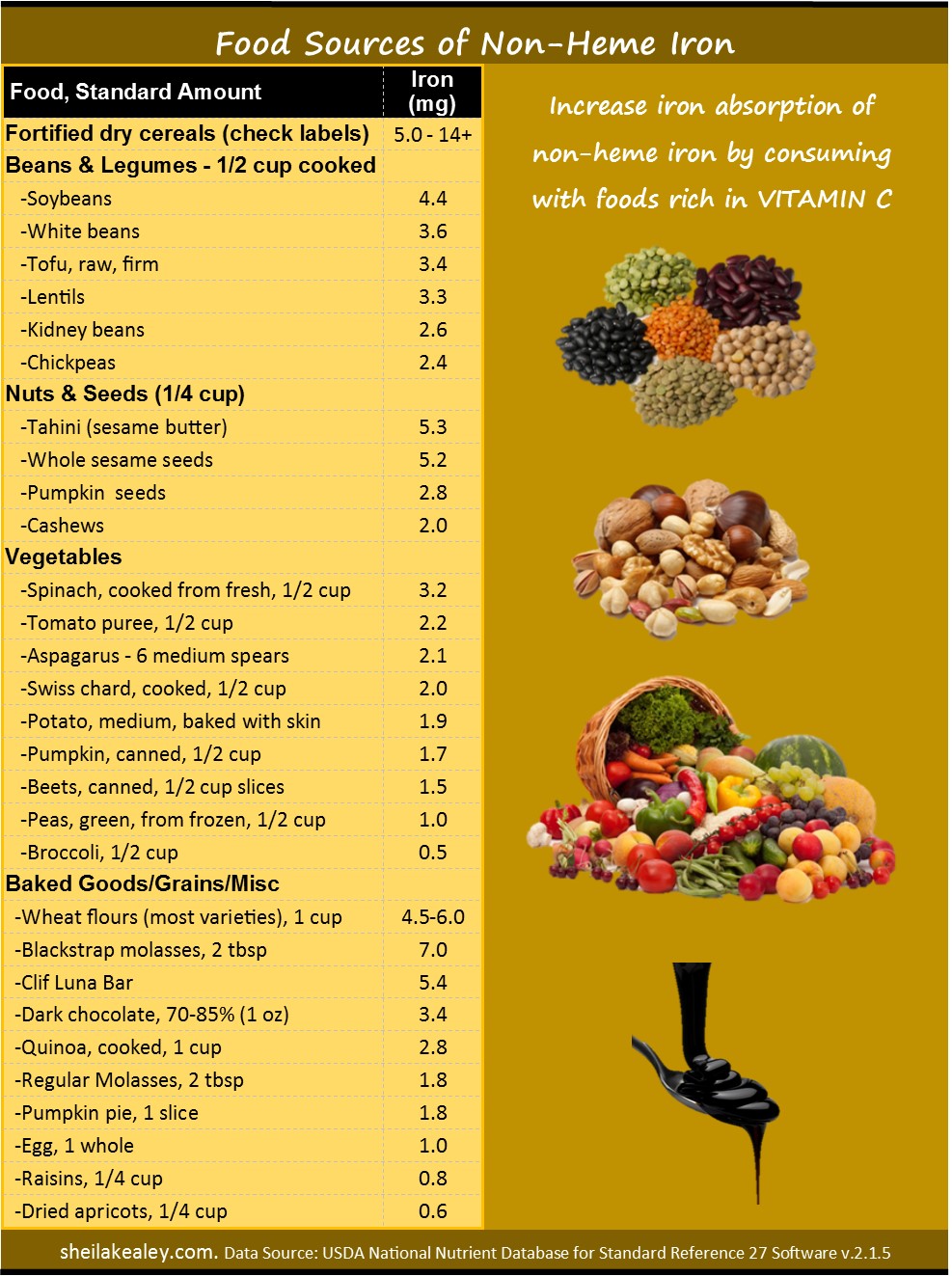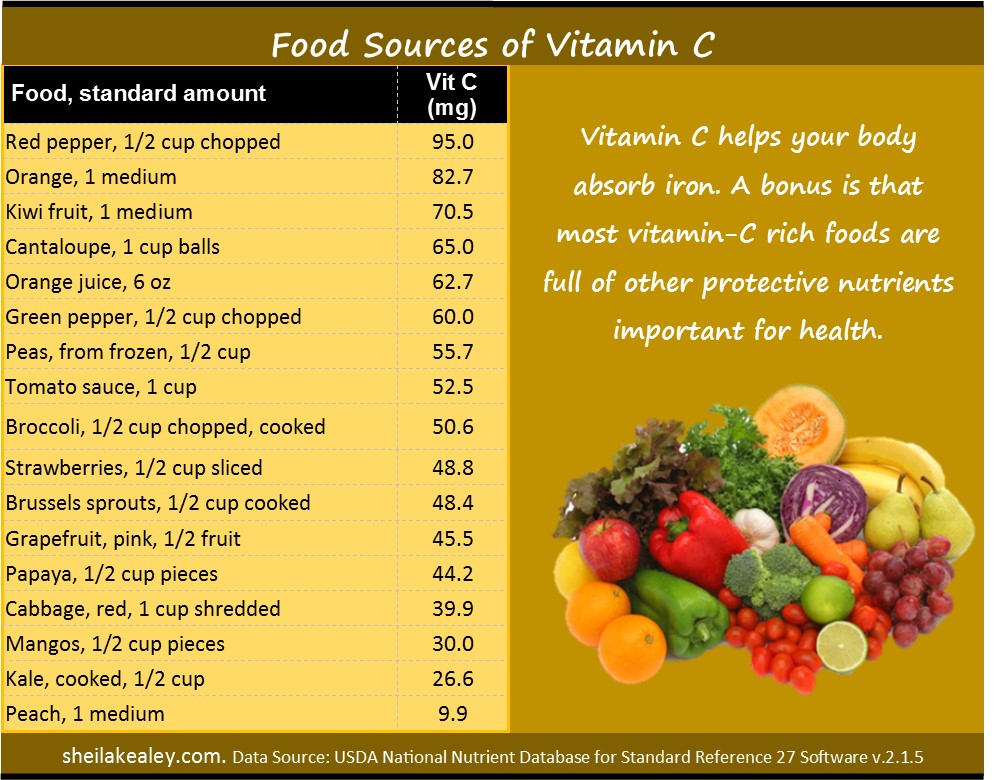Iron is essential for life – every cell in your body needs iron to function. Understandably, athletes are often concerned about iron, because iron is part of hemoglobin in blood and myoglobin in muscles, helping deliver oxygen to cells. Low hemoglobin can result in fatigue and decreased aerobic capacity, leading some athletes to assume that extra iron will enhance performance. Indeed, some endurance athletes take iron supplements regardless of their iron status, even though excess iron might compromise their health. On the other hand, truly iron deficient athletes might not be aware of their status, and changes in their diet or iron supplements might reduce fatigue or improve performance. But dietary changes aren’t straightforward because iron absorption is a complicated phenomenon. Read on to find out
-
if you might be at risk for iron deficiency
-
how much iron you need and the best dietary strategies to increase your iron intake
-
potential pitfalls to avoid when increasing dietary iron intake
Which Athletes Are at Greatest Risk for Iron Deficiency?
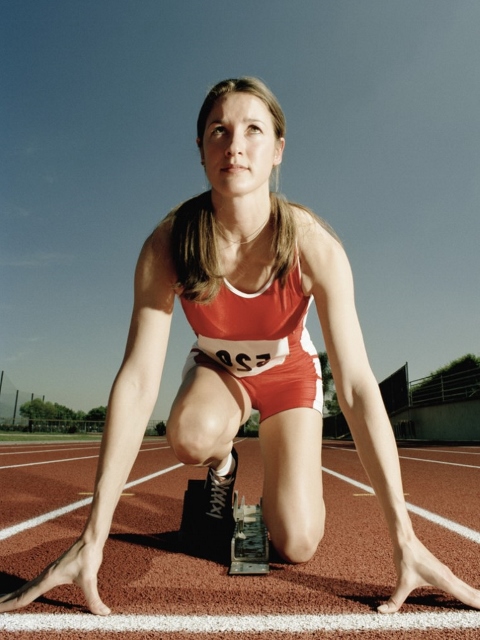
Endurance athletes, particularly females and adolescents, are at risk for reduced iron stores and anemia (reduced blood cell mass or hemoglobin concentration). Intense training increases iron demands, and exercise can deplete iron stores through increased red blood cell production, tissue inflammation, sweating, and destruction of red blood cells with impact (foot strike). Adolescents are growing rapidly and iron demands are high, and women lose iron through menstruation. Studies show that adolescents and women don’t consume enough iron in their diet, and experts believe that this inadequate intake is a major contributor to iron deficiency.
How Do I Know if I’m Deficient in Iron?
Athletes should consult a physician to get a blood test to screen for iron deficiency. Typically your doctor will look at complete blood count (CBC) measures, serum ferritin (estimate of stored iron) and possibly other specific tests to help diagnose low iron. A diagnosis of anemia often involves (1) low hemoglobin; (2) smaller than normal red blood cells; and (3) low serum ferritin.
A low ferritin level alone could be an early warning sign of anemia, so athletes with low ferritin should try to increase their iron status first by increasing the iron in their diet.
How Much Iron Do I Need?
The Recommended Dietary Allowances for daily iron intake are as follows:
-
Females 14-18 yrs: 15 mg
-
Females 19-50 yrs: 18 mg
-
Females 51+ yrs: 8 mg
-
Males 14-18 yrs: 11 mg
-
Males 19+ yrs: 8 mg
Who Needs More? Vegetarians and vegans should try to consume more iron (up to 1.8 times more), as these recommended intakes are based on the assumption that at least 10% of iron intake is from heme iron; female athletes engaging in weight bearing activities (i.e., runners) should also try to consume more iron to account for iron losses due to foot strike; pregnancy increases demands to 27 mg.
Getting Enough Iron with
a Healthy Diet
To increase your iron stores, you should consume a healthy diet that includes a wide variety of iron-containing foods. Foods contain two types of iron: heme iron is found in red meats, fish, and poultry, and non-heme iron is mostly from plant sources (enriched and whole grains, beans, nuts and some vegetables and fruit) as well as eggs and dairy products. About 60% of the iron in meat is non-heme. Here are common dietary sources of iron.
How to Figure Out the
Iron Content With Food Labels
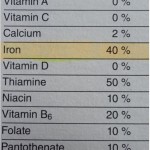 Figuring out the iron content of foods based on food labels is tricky. Although iron requirements vary by age and gender (and pregnancy, athletic, and vegetarian status), the Nutrition Facts Table for foods only has one value for iron. You need to look at the % daily value panel, and know what value it is based on:
Figuring out the iron content of foods based on food labels is tricky. Although iron requirements vary by age and gender (and pregnancy, athletic, and vegetarian status), the Nutrition Facts Table for foods only has one value for iron. You need to look at the % daily value panel, and know what value it is based on:
- In Canada, this is based on 14 mg iron (so 50% daily value means 1 serving contains 7 mg iron);
- In the US this is based on 18 mg iron (so 50% daily value means 1 serving contains 9 mg iron).
Iron Absorption
How well you absorb iron might be as important as the amount that you consume. But iron absorption is a complex phenomenon: your body only absorbs about 10-15% of the iron you eat, and the amount of iron you absorb from a food is influenced by (1) your body iron status; (2) the type of iron (heme iron is better absorbed than non-heme iron); (3) iron inhibitors; and (4) iron enhancers.
Iron Inhibitors are substances in foods that interfere with iron absorption (especially non-heme sources of iron). These include
- Calcium, dairy products, and eggs.
- Oxalates found in spinach, kale, beets, nuts, chocolate, tea, wheat bran, rhubarb, strawberries, and some herbs.
- Polyphenols – antioxidants found in some cereals and legumes, most fruits and vegetables, cocoa, coffee, tea (black, green, and herbal), some spices, and wine.
- Phytates – antioxidant compounds found in nuts, seeds, grains, soy proteins, and legumes.
You’ll notice that this list includes many healthful foods, and the health consequences of limiting or avoiding these foods (not to mention meal-planning headaches) likely outweigh the possible iron boosting benefits of avoiding them. My advice? Focus on Iron Enhancers.
Iron Enhancers
- Vitamin C helps your body absorb iron, and overcomes the negative influence of iron inhibitors. Some studies estimate that Vitamin C can increase iron absorption as much as four times. Try to include a vitamin-C rich food with meals and snacks. A bonus is that most vitamin-C rich foods are full of other protective nutrients important for health. This tables lists foods rich in vitamin C.
- Eating heme iron-rich foods with non-heme-iron rich foods helps increase iron absorption (for example, adding a small amount of meat to chili will help you absorb more iron from the beans).
- Carotenoids (beta-carotene, lutein and zeaxanthin – found in brightly-colored fruits and vegetables like carrots, greens, sweet potatoes, red peppers, cherries, cantaloupe, oranges) improve iron uptake and help overcome the effects of iron inhibitors.
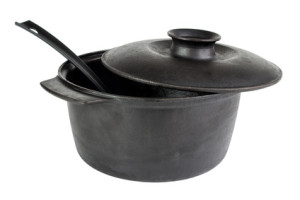 Cooking in cast iron can increase the iron content of food, especially acidic foods (i.e., tomato sauce). Studies have found that the iron content of cast-iron cooked foods was 2 to 12 times higher than foods cooked in other types of pots: more acidic, high moisture foods and longer cooking times results in more iron leaching into foods. One study estimated an increased daily iron intake of 14.5 mg for adults and 7.5 mg for children eating foods cooked in cast iron pots. (Cast iron is great for other reasons too!).
Cooking in cast iron can increase the iron content of food, especially acidic foods (i.e., tomato sauce). Studies have found that the iron content of cast-iron cooked foods was 2 to 12 times higher than foods cooked in other types of pots: more acidic, high moisture foods and longer cooking times results in more iron leaching into foods. One study estimated an increased daily iron intake of 14.5 mg for adults and 7.5 mg for children eating foods cooked in cast iron pots. (Cast iron is great for other reasons too!).
Designing Meals and Snacks
to Maximize Iron Absorption
A main focus should be to include vitamin-C rich foods with your meals and snacks. Here are some other tips and meal ideas:
- A burrito or Mexican-inspired meal containing beans and rice with salsa and sweet peppers is a delicious iron-rich vitamin C combination. Add a little lean beef or chicken to increase the iron content even further.
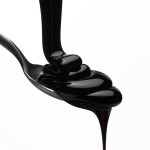 Bake with Blackstrap Molasses – it’s full of all the good stuff that’s left behind after processing sugar cane into sugar, including lots of iron and other minerals like calcium, magnesium, and potassium. Some people add 1 tbsp. to water or milk. A little can add a rich flavor to baked goods like yeast breads, quickbreads and muffins (I use 3-4 tbsp. for baking a large loaf of whole wheat bread). The flavor is intense – so experiment with just a little at first.
Bake with Blackstrap Molasses – it’s full of all the good stuff that’s left behind after processing sugar cane into sugar, including lots of iron and other minerals like calcium, magnesium, and potassium. Some people add 1 tbsp. to water or milk. A little can add a rich flavor to baked goods like yeast breads, quickbreads and muffins (I use 3-4 tbsp. for baking a large loaf of whole wheat bread). The flavor is intense – so experiment with just a little at first.- For a pre- or after-workout snack, try trail mix with iron fortified cereal (shreddies/oat squares), dark chocolate, and dried fruit with vitamin C (mango, papaya, apricot) to increase iron absorption.
- Enjoy an iron-fortified breakfast cereal with fresh berries and milk or yogurt. This is a great post-workout snack too because it includes carbs and a bit of protein. Low-sugar/whole grain varieties are your best bet.
- Top a spinach salad with vitamin-C sources, like strawberries, or mandarin oranges, and peppers (all rich in Vitamin C).
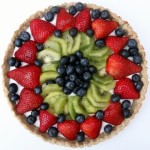 Finish off a meal with a vitamin-C rich fruit tart (try my recipe!) to improve the iron absorption of your meal.
Finish off a meal with a vitamin-C rich fruit tart (try my recipe!) to improve the iron absorption of your meal.- Add red peppers to any meal – they are the leading source of vitamin C to help iron absorption and full of other nutrients. Eat raw as a snack, add slices to sandwiches and wraps, dip into hummus, or cook into omelets, soups, and stews.
- Here are 28 iron-rich recipes from my favourite cooking magazine Eating Well.
Iron-Seeking Focus that
Might Compromise Your Health
When an athlete thinks they need to increase their iron intake, they tend to focus exclusively on this one mineral at the expense of their overall diet. Here are some things to think about:
Too much red meat. Some athletes increase red meat intake considerably to boost iron levels. Although heme iron is best absorbed, eating large amounts of red meat is not recommended for overall health. Leading health organizations recommend limiting red meat intake to reduce risk of cancer, Type 2 diabetes, cardiovascular disease and metabolic syndrome. You don’t need to exclude red meat, but for overall health it’s best to consume smaller amounts and include other sources of heme iron (poultry, fish) and non-heme iron in your diet.
Confusion with clams. Many reputable health websites and resources list clams as an excellent source of iron (23 mg per 3 oz; which is 6 mg more than the daily recommended allowance for women). I wouldn’t recommend eating clams often as your iron source. Recent research shows complications with this iron data, as the actual amount of iron in clams differs widely by the type of clam, and it is generally modest (1 mg per 3 oz serving for chopped of minced clam products). The study authors also found that nutrition label data for iron in clams is inaccurate, and that clams have much less heme iron than once thought. Clams with the highest iron content are baby clams, but eating large amounts of these clams is not recommended as they are high in aluminum and can accumulate cadmium and lead, contaminants that can cause adverse health effects.
Too much focus on inhibitors. Many foods that limit iron absorption are extremely nutritious and important for overall health. Some people limit legumes, seeds, and nuts because of their phytate content – yet these foods are nutrition powerhouses! Although if you’re trying to maximize iron absorption you might not want to drink tea or coffee with every meal, but a focus on enhancers, especially vitamin-C rich foods, will lead to a healthier overall diet.
Orange juice as main vitamin C source. For optimal nutrition, limit orange juice as your vitamin C source: it is very high in sugar and lacks the fiber to moderate the sugar absorption. Instead, eat a variety of vitamin-C rich fruits (e.g., kiwis, citrus fruits, strawberries, mangos, cantaloupe) or vegetables (red and green peppers, broccoli, greens, tomato sauce, cabbage). You’ll benefit from a wide array of health promoting substances, in addition to vitamin C to increase iron absorption. See the Table above for a variety of Vitamin-C rich fruits and vegetables.
Do I Need an Iron Supplement?
If dietary measures aren’t effective for improving iron stores, iron supplementation is often considered. As iron pills often have side effects (constipation, diarrhea, stomach upset), and excess iron stores are a great health risk and associated with chronic disease, it’s important to take these supplements under the guidance of your physician. In some cases, iron injections may be considered to boost iron levels. You can find more information about iron supplements here.
What if I Have Low Ferritin but Normal Hemoglobin?
Many female athletes have low ferritin with normal hemoglobin levels. Some athletes and coaches believe that this status causes fatigue and may compromise aerobic capacity, and turn to iron supplements as a way to increase energy and improve race times. It is currently unclear whether or not iron supplementation will improve aerobic capacity in athletes with low ferritin without anemia, but research is ongoing. A small number of studies suggest that iron supplementation may reduce fatigue in women with low ferritin, but results have been mixed, and again, more research is needed. The optimal ferritin level for athletes is widely debated: many studies use a ferritin level of <12 mcg/L to define iron deficiency, although benefits of iron supplementation have been shown using higher ferritin cut-offs (up to 60 mcg/l). Some experts believe that ferritin and hemoglobin levels are relative (i.e., one athlete may be fine with hemoglobin level of 13 g/dl, while another may be anemic at this level). Consider this Olympic 1500m runner who improved steadily despite depleted iron stores (low ferritin levels).
If your iron stores are normal, there is little robust evidence to suggest that taking iron supplements will improve aerobic capacity or reduce fatigue. In fact, this practice is risky because excess iron is associated with health problems. Fatigue has many causes, and it’s important to consider the athlete’s training plan, life stressors, sleep, diet (i.e., restricting calories and/or carbohydrates), and other factors – in addition to iron status – that might be contributing to fatigue.
More Sports Nutrition Articles
- Nutrition Strategies for Health and Athletic Performance
- Dietary Nitrates, Sports Performance, and Health
- Athletes Avoiding Gluten and Grains: Is There Good Evidence?
- Healthy or Hype? Chocolate Milk for Recovery
- How Much Protein Do You Need?
- What Should I Eat Before I Workout?
- Energy Bars: What to Look for, Real Food Alternatives, and How to Make Your Own
- Will Beet Juice Improve Endurance Performance?
- Refueling for Recovery
- You Fuel your Workouts, but How Does the Rest of your Diet Stack Up?
Share This:
